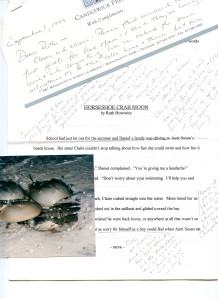While everyone else is starting their summer vacations, I’m heading back to school. On Monday I’ll be teaching a class of 5th and 6th graders about “being an author.” That’s how my friend phrased the request, anyway.
I said yes because I haven’t done one of these gigs in years, and I remembered they were fun. Also, when my friend asked, the date was an entire month away. The then-Present Me blithely agreed, figuring the chips would fall on some hapless Future Me. Trouble is, that former Present Me has by now morphed into a smug Past Me. She’s off somewhere sitting on her duff, no doubt eating bonbons. In other words, it’s time to get it together.
I have 90 minutes to fill. My plan is to spend the first half talking about my life as an author, focusing mostly on Crab Moon. To prepare, I pulled out my Crab Moon archives. That’s a foot-high stack of file folders – printed-out email messages from my Aunt Susan, drafts, correspondence with Gale Pryor, my wonderful editor at Candlewick, a packet of photographs of horseshoe crabs sent by my cousin David, notes from phone calls with Gale, more drafts, photocopies of fab illustrator Kate Kiesler’s sketches, dummies and paintings, yet more drafts, business correspondence, and finally page proofs, published reviews, and letters from readers.
I had remembered how long the process of bringing the book to publication was. But I had forgotten the particulars. Looking through the old drafts and letter now, searching for the essential artifacts that would tell my audience something interesting and useful, I was struck by
— how much the story changed between my first idea and the final book
— how much better (cleaner, sharper, more focused, better paced) the book is than my first idea
— how much of that cleaning and sharpening and focusing and pacing is the work of my editor (although the actual words on the page are mine)
— how lucky I am to have landed in some patient, capable and persistent editorial hands.
The second half of my class will be a group exercise in literary analysis. We’ll compare three picture-book treatments of The Little Red Hen, discussing the different choices the authors made, and talking about which elements are essential to keeping it the same story (could you write a version without the character of the little red hen, and still consider it The Little Red Hen?).
I could spend days (year, a life time) on this stuff. But I only have an hour and a half. And my audience of 10 and 11-year olds probably doesn’t share my passion. What do I want them to take away from the session?
— Real people write books.
— There is no one right way to tell a story.
— In picture books, the words and the images work together to tell the story.
— Writing in any genre involves lots of conscious or unconscious decisions.
— Writing well in any genre takes patience, persistence, and a willingness to listen to constructive criticism.
— A great editor can be a book’s greatest asset.
Tags: crab moon, Editor, picture books, writing

June 19, 2012 at 4:16 pm |
Don’t forget to break up your talking with stuff for them to do and/or talk about. Kids that age do NOT want to sit and listen to anyone or anything for an hour and a half! 😀 But you probably knew that already.
June 19, 2012 at 4:18 pm |
Sheesh. I know that. I’m building in lots of places for them to do stuff. You want I should post my whole lesson plan?
June 19, 2012 at 4:19 pm |
I mean, thanks!